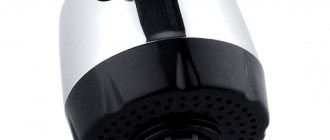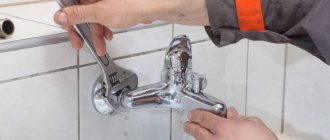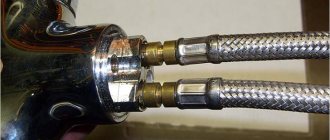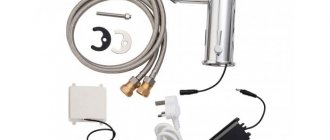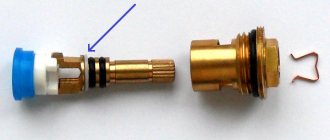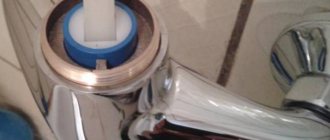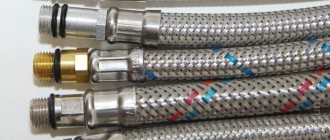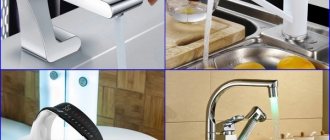An aerator for a mixer is a device for limiting and filtering the flow of water without reducing the pressure of the stream. The device is attached to the end of the faucet in the bathroom or kitchen, and is also installed on the bidet faucet. It can be stationary or on a hose. Consultants of the Plumber Portal website will tell you in this article what other types of this water-saving device there are.
Design and principle of operation
The faucet aerator with external thread is a mesh filter that is installed on the faucet spout. The main function of this device is to mix water with air.
The name of the device comes from the task performed. “Aeration” translated from Greek means “air”, and the function itself is the process of natural saturation of a water flow with air. Thus, water consumption is reduced by up to 50%.
Without an aerator, a continuous stream flows from the mixer, but with a nozzle, the liquid becomes saturated with air bubbles, loses its elasticity and takes on a seething appearance. Such a flow does not splash when colliding with the walls of the sink or dishes, but smoothly washes them.
Modern aerators are equipped with perforated discs and a multi-stage filtration system.
The design of the faucet nozzle includes three main components:
- The body is made of plastic or metal. Designed to protect the structure from mechanical damage.
- A modular system consisting of a slotted cartridge with slots or a disk reflector with small diameter holes. Performs the function of mixing water with air and flow limiter.
- The sealing ring is made of dense rubber. Serves to seal the connection between the nozzle and the water tap.
The filter of this device is a set of meshes with small cells, which are sequentially laid in a cylindrical element. The first two layers are responsible for the function of rough water purification and also set the direction of the stream, the next ones serve to mix the liquid with air.
Structurally, aerators from different manufacturers may have some differences. The simplest ones look like a plastic liner. Those that are more expensive, more modernized designs look like a multi-stage mesh filter.
If the faucet spout does not have a thread, then installation of the aerator will be possible only after the mixer has been installed.
Classification by installation method
In appearance, aerators are either internal or external.
Another quite important classification is the installation method. Based on this feature, aerators are divided into two main categories:
- The internal installation method requires external threads. In this case, the structure is placed in the inside of the spout. The peculiarities of this version include the fact that it does not change the design of the mixer, which means it is suitable for almost any application. In addition, the design itself is protected from mechanical stress, which means you can choose plastic aerators, which are cheaper.
- The external type of installation is widespread; the body has an internal thread, the aerator is screwed onto the spout. Most often, external aerators are made from brass or stainless metal, since these materials are less susceptible to mechanical stress. However, in the case of external installation, dismantling the nozzle is greatly simplified, since during internal installation, for example, an aerator made of extruded aluminum is quite difficult to remove after it has oxidized.
Determining the type of installation is quite simple by the location of the thread.
What types are there?
Classic faucet aerators are usually divided into two types:
- with adjustable flow - their advantage is that with their help you can set the required jet size;
- with unregulated flow.
Among the classic designs, rotary type aerators are in first place in the ranking. Due to the presence of a hinge type connection, they have the function of changing the angle of the outgoing flow, which makes washing dishes or taking water procedures more comfortable.
To save water, the body of the aerator for the mixer can be made of the following materials:
- brass - considered the best material, if the device body is made of it, it will last for quite a long time;
- pressed metal - a combination of relatively affordable price and durability;
- plastic – the most budget-friendly device options are made from this material, but in terms of quality and durability, these devices are significantly inferior to their metal counterparts.
A serious disadvantage of nozzles made of metal is their relatively short service life. This is a consequence of the fact that the metal is quickly destroyed due to impurities present in tap water.
How to choose an aerator that will provide low water consumption? The best choice in this case is a vacuum device. Due to the constant mixing of air in the vacuum device, the effect is created that a constant pressure is maintained in the mixer. But in reality, water consumption decreases.
If you follow the recommendations of experts, then your choice should be made in favor of models that have an additional silicone coating. They are virtually impervious to lime build-up and can be cleaned with just a simple touch with your finger.
Upgraded devices equipped with backlight. When arranging modern kitchens and bathrooms, most owners attach great importance not only to the functionality of the devices, but also to their aesthetic appearance.
The jet is illuminated automatically; you just need to open the tap slightly. A turbine with an electric generator and a temperature sensor is installed inside the housing of such a unit. The device is made in such a way that the color of the backlight directly depends on the temperature of the water flowing from the tap:
- cool water, whose temperature does not exceed 31 ° C, is colored green;
- warm, whose temperature is within 43 ° C, is painted with blue rays;
- hot, with a temperature of more than 45 ° C, is highlighted in red.
In addition to the aesthetic function, the backlight reports the temperature of the liquid that flows from the tap. The operating temperature of this type of device is limited to 60 degrees.
In homes where there are small children, nozzles in the form of animal figures and fairy-tale characters are especially popular; they have a universal size, so they can be attached to faucets with any type of spout.
Another popular nozzle is the spiral one. The faucet turns the flow of water into an elegant, intricately twisted spiral. Numerous jets emanating from the tap twist into spirals, which, intertwining with each other, create a beautiful water grid at the outlet.
Rules of care
In order for the device for economical water consumption to work correctly, it is necessary to ensure timely cleaning of the filter system from clogging. The quality and intensity of the flow depends on the serviceability of the device. Over time, solid particles and plumbing debris accumulate in the mesh membranes of the aerator, and the device ceases to perform its functions. The main signs of malfunctions are weak pressure, a minimum number of air bubbles, unevenness of the jet and the absence of a characteristic hissing sound. The procedure for dismantling, cleaning and reinstalling the device is as follows:
- Using a mechanic's wrench or pliers with wrapped paws, carefully unscrew the aerator, being careful not to damage the tip of the tap. You can wrap the head of the device with a rag.
- You need to use a 22mm wrench, grabbing the device by the flat edges located diametrically opposite each other. The aerator must be turned clockwise.
- After this, pry up and pull out the rubber seal from the mixer, rinse thoroughly with water and check its condition. A worn or deformed gasket must be replaced.
- The aerator is sequentially disassembled, removing the filters from the housing. Small holes in the spherical mesh element are cleaned with an awl or a needle and washed under high pressure of water.
- If caked-on salt deposits remain on the filters, they must be removed using a special compound. For example, you can place the mesh in apple cider vinegar or detergent.
- After cleaning, the aerator is assembled in the reverse order and screwed into the tap or mixer counterclockwise. To do this, use pliers, a wrench or pliers.
Rubber seals cannot be washed with chemicals. If the gaskets are worn out, it is not recommended to put them back in the aerator - the products must be replaced. When tightening the device, do not apply too much force to the economizer so as not to strip the thread. Before use, check the tightness of the connections and, if necessary, tighten the device a little more. The process of cleaning or replacing the aerator is not difficult.
The economizer works by mixing water and air. As a result, the device makes noise during operation, which causes some discomfort. To reduce the noise level of the device, it is recommended to check the condition of the filters. If they become dirty, the flow dries up, and the water can “swirl” in places where debris accumulates the most. This creates noise, which can be reduced by cleaning the device.
What are the advantages and disadvantages?
The main advantages of the aerator are:
- Saving water consumption. In normal mode, about 15 liters of water can flow out of the tap in one minute. But when it is equipped with a nozzle, this flow rate is reduced to 6-7 liters per minute.
- Reducing the noise of plumbing equipment. It has been noticed that water supplied with an admixture of air makes less noise.
- Improving water quality. During aeration, water is saturated with oxygen. This reduces the percentage of chlorine, which is very harmful to health. The water that is passed through the aerator allows you to much faster wash away detergents that were used while washing dishes or when taking water procedures.
The price of a bathroom aerator, depending on the manufacturer, ranges from 2 to 10 dollars. Thus, purchasing this device will not hit your budget too much.
You can install the device yourself without turning to specialists for help.
When it comes to the disadvantages of the unit, the following points should be noted:
- These devices require frequent repairs or even complete replacement of the device if the water in the system is of rather poor quality. And if the pipeline in the house is old, then the device will need to be replaced annually.
- Reducing the volume of incoming water can seriously affect the speed of filling containers (bathtub, sink or large pan).
These devices have no other disadvantages.
Manufacturers
- Kaiser – Quality of inexpensive models.
- Iddis – Reliability, design.
- Frap – Traditional type of mixer, aerator, swivel spout.
- Zorg is a combination of price, quality and functionality.
- Omoikiri – 5 year warranty. Double spout for running and drinking water.
- Lemark – Faucets painted to match the color of the sinks. In-line dispenser for liquid detergents.
- Blanco – Granite faucets. High safety and hygiene.
- Grohe - Water treatment systems.
- Hansgrohe - Build quality. Magnetic mount. Nozzles are used to protect health from the harmful effects of chemical impurities in drinking water.
The best aerators for faucets
Rating of the most popular aerators with external threads:
- Elghansa М28×1. German quality at European prices. The average cost is 750 rubles.
- Timo SV-10. Dual-mode aerator from Finland with high quality characteristics. Price from 600 rubles.
- Presto with hose. High quality Czech part. The average price is 620 rubles.
- Kaiser B16 articulated. German aerator designed for bidets. Cost from 200 rubles.
- Tescoma 111001. Another good quality item from the Czech Republic. Cost from 275 rubles.
- Remer M28. Italian device with excellent characteristics. Cost from 200 rubles.
- Remer Premium M 24. Less expensive, but no less high-quality element. The average price is 175 rubles.
- D&K DC1600201 M28X1. The best model of aerator with external thread from China. Price from 130 rubles.
- GANZER GZ A004. Product from Germany with external thread and average characteristics. Cost from 100 rubles.
- MasterProf with ½" external thread. Budget domestic option of average quality. Price from 35 rubles.
When compiling the rating, materials from the highest sales reports were used, and the opinions of customers who already use these products were taken into account.
Device installation rules
It is often necessary to install or replace the aerator in the mixer. At this stage, it is necessary to understand how the installation takes place.
During installation, you must adhere to the following rules:
- The device is equipped with a rubber sealing gasket, which serves to seal the connection between the tap and the aerator. Installation of the aerator begins with the installation of this part. If the unit is not equipped with it, then this gasket must be purchased separately;
- If it is necessary to install an adapter, you must choose the right water-saving device. The material for the adapter should be the same material from which the aerator body is made. For example, if the aerator has a brass body, then it is more rational to use a brass adapter;
- in the case when a metal adapter with a thread is used during installation, gaskets must be installed at both connection points;
- The installation of the aerator must be carried out with the greatest possible care in order to prevent the possibility of possible damage to the external surface of the equipment. When tightening threads with pliers, it is recommended to use protective cloth or special insulating pads to prevent the working plane of the tool from coming into contact with the coating;
- Installation of the unit on the shower should be done in a similar way at the junction of the shower and the mixer.
The thread should be tightened moderately. If the tightening is weak, the tightness will not be complete, and if tightened too much, the body of the aerator or faucet may burst.
Getting ready for work
I would like to note right away that reading this article will probably take more time than it will take to complete the work described below, due to its simplicity.
To clean the aerator we will need:
- rags;
- old toothbrush;
- knife;
- an adjustable wrench of at least 22 mm or a suitable open-end wrench.
The last position is useful if the aerator has been tightly screwed in or has become sour in the housing.
How to clean the aerator from dirt?
Tap water contains small solid particles of scale and metal oxides (rust), which can eventually settle in the mixer aerator meshes, causing them to become clogged. As a rule, this happens after repair work is carried out and the water is turned off. As a result, the stream of water breaks into several, causing it to splash all over the sink and beyond.
In such a situation, it is necessary to clean the aerator grids. For these purposes, there are edges, thanks to which you can unscrew the aerator using a wrench. This must be done very carefully, as there is a possibility of damaging the nickel plating.
- You need to unscrew it using pliers, wrapping the head in a dishwashing napkin in advance. Unscrewing occurs clockwise when looking at the tap from above. If the rubber gasket does not fall out after unscrewing, it must be removed from the tap in order to assess its condition.
- After that, pressing with your finger from the place where the water exits the head body, you need to squeeze out the cylinder with plastic mesh filters.
- The next step is to remove the plastic double primary filter from the cylinder using the tip of a knife. Care must be taken to avoid cuts. To remove it, you can also use a thin flat-head screwdriver through the slot in the side. It all depends on what someone thinks is convenient.
- After the mesh filter is removed from the cylinder, the upper spherical mesh is separated from it, which is pryed off with the tip of a knife.
- The lower part of the filter is placed under running water and the holes are cleared of dirt using a needle or thin awl. In the same way, you need to do the spherical part of the structure.
- A layer of metal mesh, which is located in the lower part of the cylinder, still remains uncleaned. They can be squeezed out with your finger and also rinsed under running water. If there are still small particles left between them, this means that they need to be separated from each other and washed separately.
There is an easier way - you need to take half a mug of water and pour a bag of citric acid into it. As soon as it starts to boil, throw the entire collected element into it and let it simmer a little. With the help of acid, all impurities will dissolve, and there will be no need to bother with a needle.
Tip: If the faucet needs to be cleaned of limescale, it is recommended to use a limescale remover for cleaning.
After all parts of the aerator have been cleaned, they must be assembled. Before reassembling the aerator, you need to put a rubber gasket on top and screw it together. Twisting occurs counterclockwise when looking at the faucet from above.
You don't need to tighten it very hard; it's enough to tighten the aerator for a faucet with an external thread by hand. Then open the water, if water flows from under the head, you need to arm yourself with pliers and a dishcloth and tighten it a little. Usually, once the rubber gasket is in place, it won't take much effort to tighten it.
Water saver in the form of a faucet attachment true or false
By the way, some aerators are made of plastic.
Aerator attachment for faucet: why is it needed?
As you probably already guessed, one of the main purposes of the aerator on the mixer is to filter the incoming drinking water. The fact is that even though water goes through various levels of purification before it enters the water supply, it still contains small particles. These are, first of all, pebbles, elements of rust, and scale that appear in water when it comes into contact with water pipes. Despite their very small size, these particles settle perfectly on the mesh surface of the aerator.
However, this is not the only purpose of the filter attachment. Another purpose of using an aerator is to save water. Agree, we all love to wash our hands or dishes under a large stream of water. The aerator allows you to save water because, separating tap water into mesh layers, it mixes air bubbles into it. Thanks to this, the flow of water from the mixer visually seems large to us, although in fact it is less than what we are used to. In addition, the aerator for the mixer serves to even out the stream, it always flows instantly and without delay. But in those taps that do not have this attachment, the stream flows crookedly and splashes.
As you can see, an aerator for a mixer is a necessary accessory.
What types of faucet aerators are there?
Nowadays, almost every faucet includes this attachment. The most common type is a rotary aerator for a mixer, thanks to which we can combine cold and hot water and get a pleasant warm stream at the output.
But for lovers of original little things, an illuminated faucet aerator is suitable. It has built-in diodes with a temperature sensor, powered by a microturbine. When you turn on the water, the sink is illuminated by a pleasant, dim light emanating from the tip of the tap. Moreover, depending on the temperature of the jet, the color changes: at a temperature of less than 29 ⁰C, green lighting is emitted, at 30-38 ⁰C - blue, and above 39 ⁰C - red. By the way, with the help of this attachment, the process of teaching children to wash their hands will go much faster.
In homes with excellent tap water pressure, you can install a rotating faucet aerator. Thanks to the hinges built into it, it is possible to switch between a regular stream or shower mode, or direct the stream - you just need to turn the nozzle.
When purchasing a faucet or a separate aerator, it is important to pay attention to the materials from which the nozzle is made. The aerator consists of a housing, mesh filters and a rubber gasket. The body can be metal or plastic, the latter option being cheaper, but short-lived and cannot withstand strong pressure from tap water.
The body can be metal or plastic, the latter option being cheaper, but short-lived and cannot withstand strong pressure from tap water.
However, the metal body is not of the same quality: it is better to give preference to brass, but pressed metal is not much more durable than plastic
The body can be metal or plastic, the latter option being cheaper, but short-lived and cannot withstand strong pressure from tap water. However, the metal body is not of the same quality: it is better to give preference to brass, but pressed metal is not much more durable than plastic.
